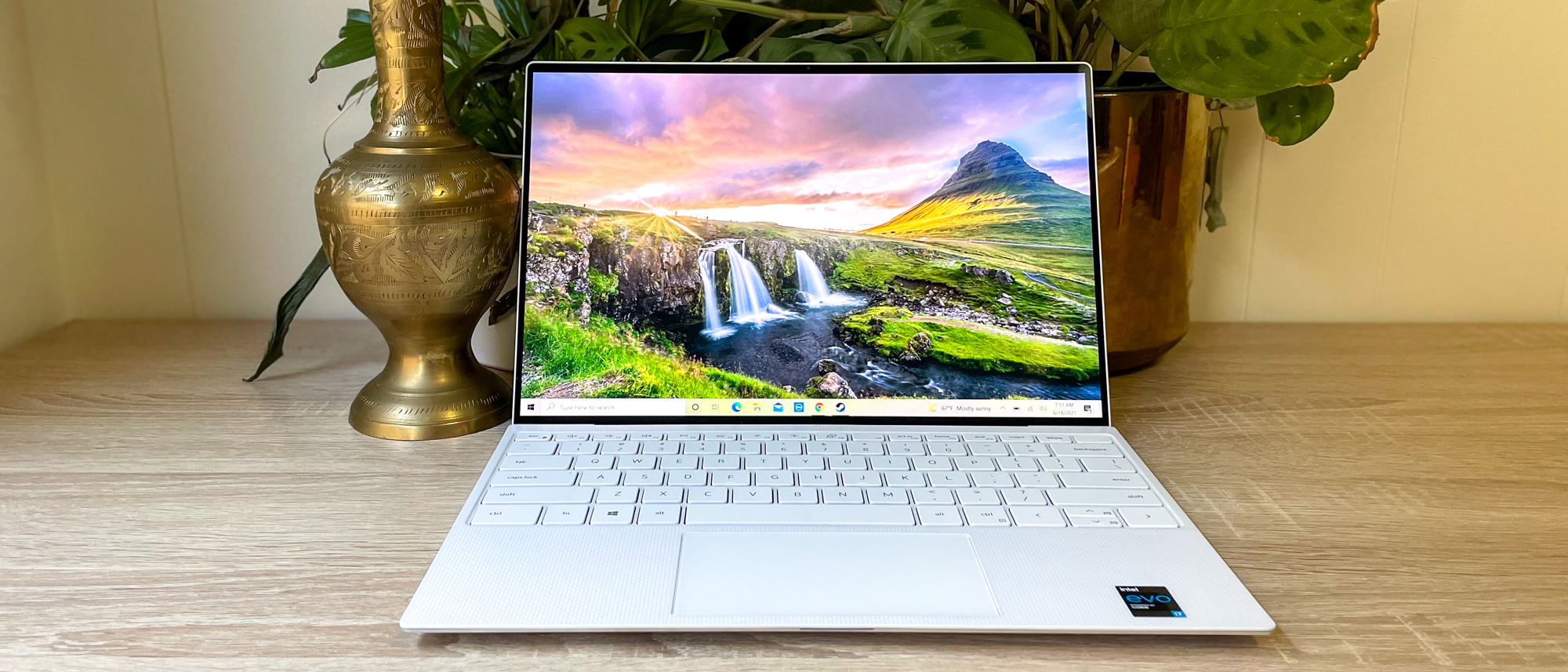Tom's Guide Verdict
Adding an OLED display makes one of the best laptops on the market even better. With great performance, a stylish chassis, and a beautiful 3.5K OLED touchscreen, the Dell XPS 13 with OLED is a premium Windows laptop.
Pros
- +
3.5K OLED display delivers vibrant colors and deep blacks
- +
Slim, attractive chassis with beautifully thin bezels
- +
Strong performance
- +
Comfy keyboard
Cons
- -
Grainy 720p webcam
- -
Paucity of ports
- -
Battery life could be better
Why you can trust Tom's Guide
The Dell XPS 13 is held in high esteem here at Tom's Guide: the fact that it packs powerful components into a slim, stylish chassis with remarkably thin bezels makes it one of our top picks for the best Windows laptop you can buy, and one of the best laptops period.
Price: ~$1,699
Display: 13.4-inch OLED touchscreen (3,456 x 2,160 pixels)
CPU: 11th Gen Intel Core i7-1185G7
GPU: Intel Iris Xe integrated graphics
RAM: 16 GB
Storage: 512 GB SSD (1/2 TB also available)
Ports: 2 Thunderbolt 4/USB-C ports, headphone jack, microSD card reader
Size: 11.6 x 7.8 x 0.5 inches
Weight: 2.8 pounds
In 2021 Dell unveiled a new configuration of the XPS 13 that comes with a 3.5K OLED touchscreen, and after spending some time with a review unit I can tell you that the addition of OLED makes this great ultraportable even better. In fact, it's so good that it leads our list of the best 13-inch laptops on the market.
You can expect to pay a couple hundred bucks extra for the privilege of an OLED screen in your XPS 13, but if you care about image quality, it's absolutely worth it. OLED displays are known for delivering vibrant colors and deep, rich blacks, and after some thorough testing (read: watching way too much UHD TV) I'm here to tell you that the XPS 13 with OLED does exactly that. The fact that it's mounted in the XPS 13's nearly bezel-less InfinityEdge display only enhances the appeal — read on for a full review of Dell's latest addition to the XPS 13 line.
Dell XPS 13 review: Price and availability
- OLED screen is a $400 upgrade
- Expect to pay at least $1,650 for an XPS 13 with OLED on Dell's website
You can purchase an XPS 13 with a 4K OLED display right now on Dell’s website, and you may also be able to find it at select retailers. The OLED display is technically a $400 upgrade; at the time of writing, you can get the lowest-spec Dell XPS 13 for $979, but that’s a model with an Intel Core i3 CPU and a 2K non-touch screen. To get the 4K OLED display, you can expect to pay (at time of publication) at least $1,649; that gets you an Intel Core i7 CPU with Iris Xe integrated graphics, 16 GB of RAM, and a 512 GB SSD, though you can pay over $2,099 if you configure a model with the maximum 2 TB of storage.
Our review unit came configured with the 512 GB SSD, and at time of publication it would have had a $1,699 price tag. That includes an extra $50 for Dell’s Arctic White paint job, which decks the interior of the laptop out in a soft white. It’s a nice look, but you’ll have to decide for yourself if it’s worth the extra cost — the XPS 13’s default matte black interior is completely serviceable.
As an FYI, the Dell XPS 13 Plus is now on sale starting at $1,399.
Dell XPS 13 review: Design
- The XPS 13's slim chassis and incredibly thin bezels are still eye-catching
- Optional Arctic White paint job looks great
We’ve reviewed a couple of Dell XPS 13 configurations at this point, and each one earned praise for its slim, stylish chassis and incredibly thin bezels. The addition of a 4K OLED touchscreen does nothing to mar the XPS 13’s design strengths; this is still a trim, light, sturdy 13-inch laptop with super-thin bezels around all four edges of Dell’s InfinityEdge display.
Get instant access to breaking news, the hottest reviews, great deals and helpful tips.
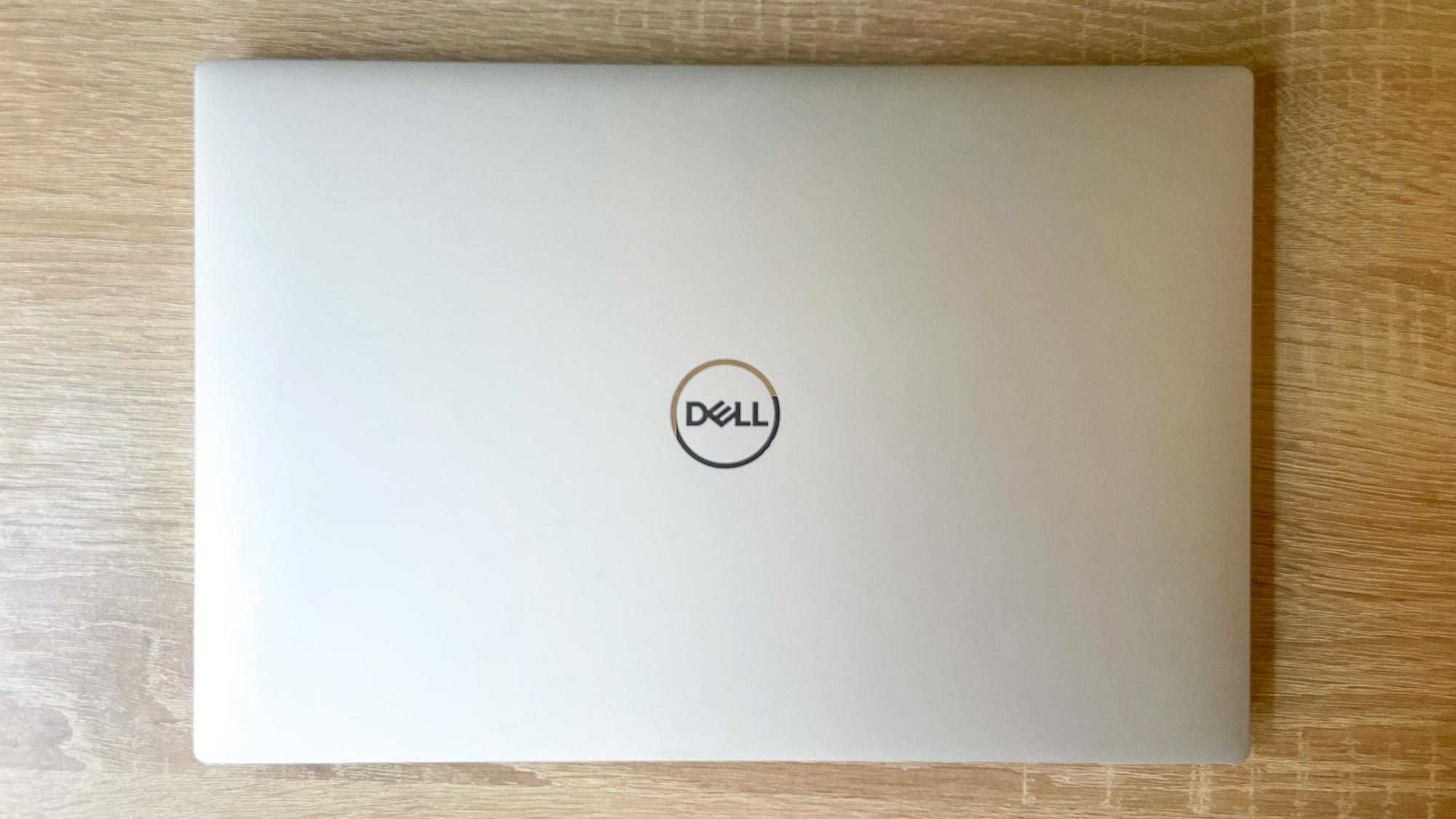
At 11.64 x 7.82 x 0.58 inches and 2.8 pounds, this OLED-equipped XPS 13 weighs as much as a MacBook Air with M1 and measures slightly smaller, though Dell’s latest still can’t match the 0.45-inch thin, 2.5-pound Lenovo ThinkPad X1 Titanium Yoga. But then, the Titanium Yoga costs more and only comes with a 2K display.
Dell XPS 13 review: Ports
- Still just two Thunderbolt 4/USB-C ports
- USB-A to USB-C adapter included, which is a nice touch
With a slim chassis comes a slim port selection: the Dell XPS 13 sports a pair of USB-C/Thunderbolt 4 ports, one on either side, as well as a headphone jack and a microSD card reader.
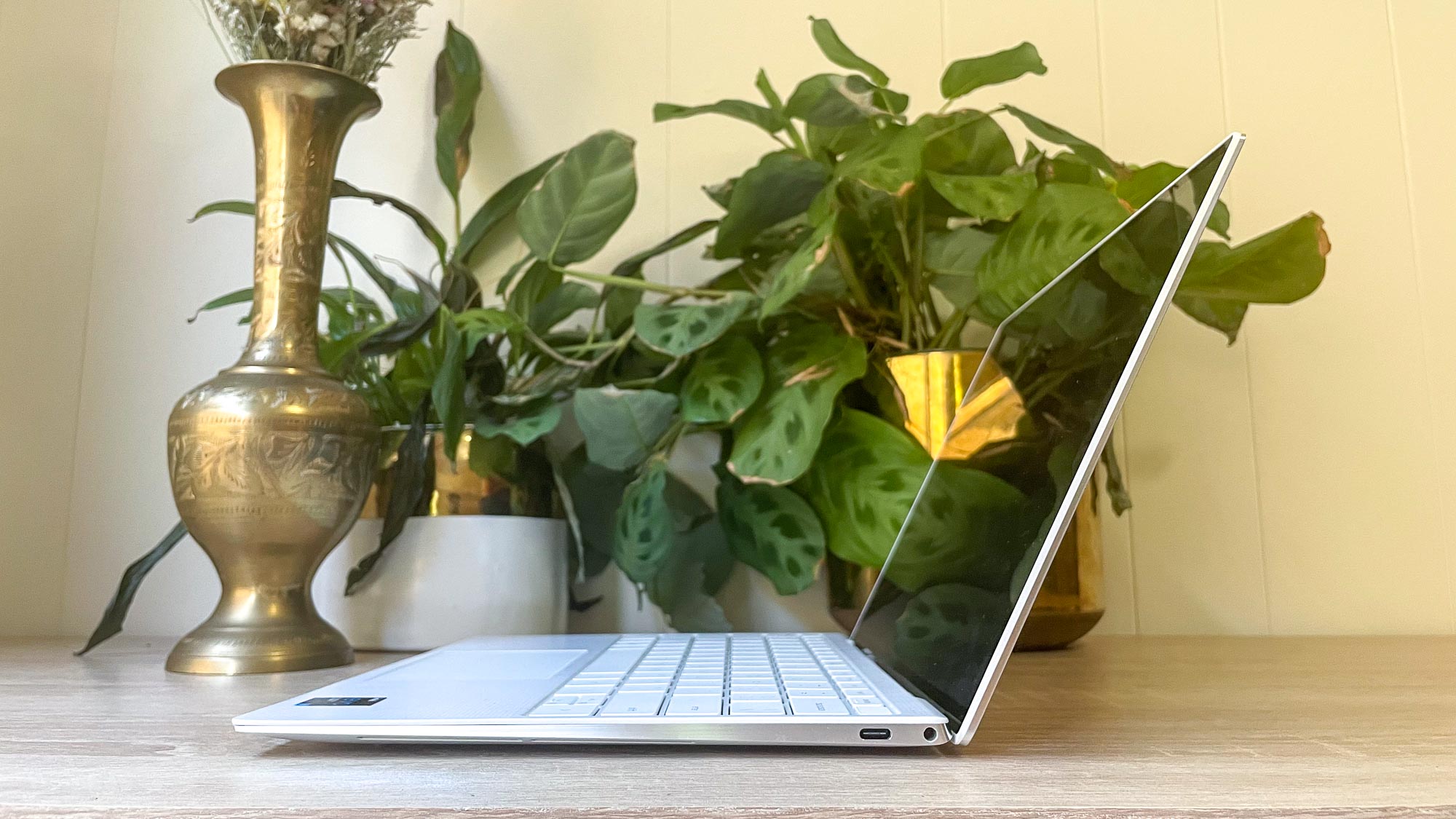
The freedom to plug in the USB-C charger on either side is nice, but the lack of a USB-A port will hurt if you hope to use a mouse, keyboard, or other accessories more than a few years old.
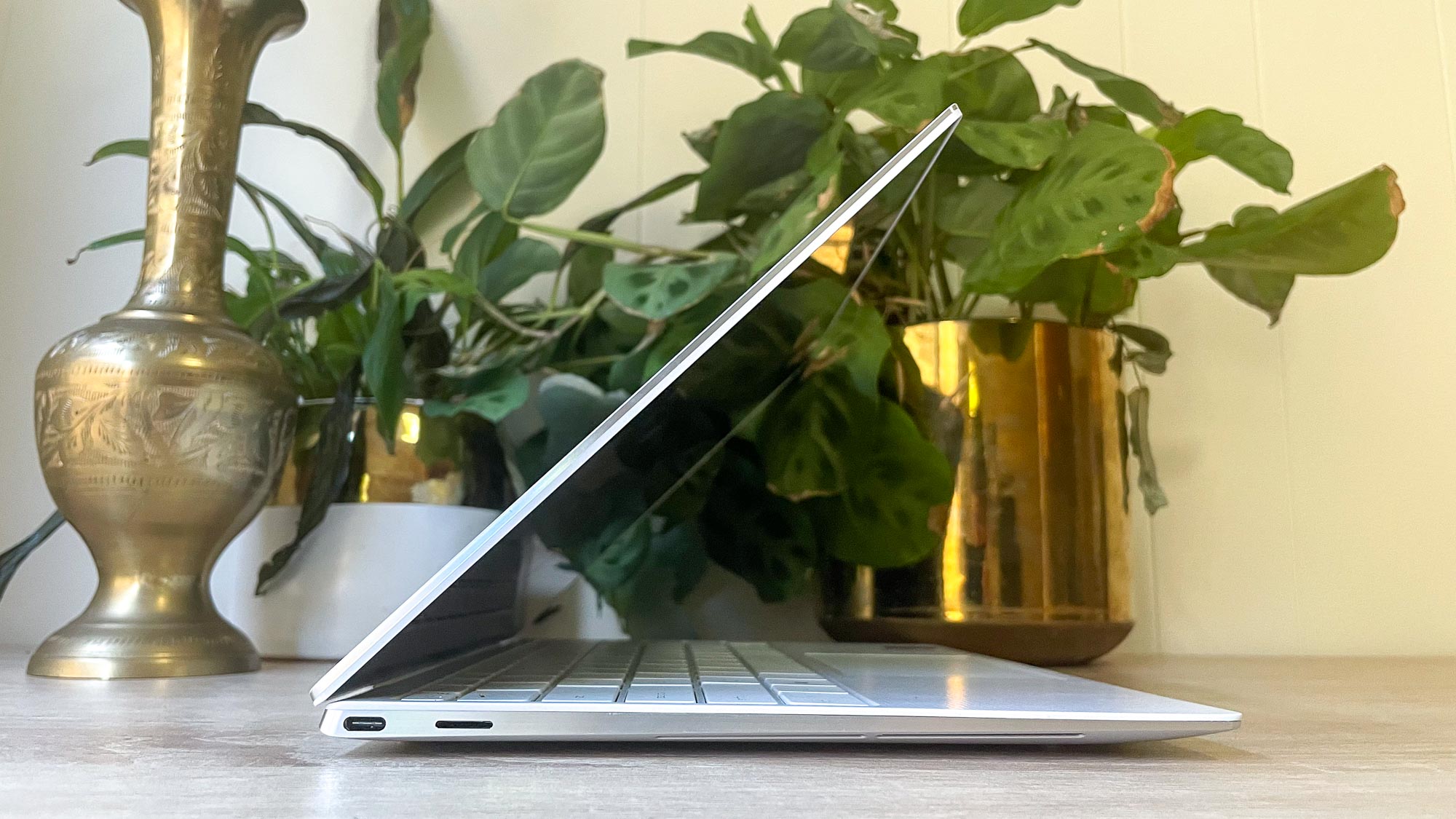
However, Dell does include a USB-C to USB-A adapter in the box, which is a nice touch I wish other manufacturers would copy.
Dell XPS 13 review: Display
- 3.5K OLED display looks gorgeous
- Super-thin bezels disappear into the inky blacks of the display
A 3.5K OLED display is the big selling point of this Dell XPS 13 configuration, and in person it looks gorgeous. With a native resolution of 3,456 x 2,160 pixels it’s not quite 4K, but it does support HDR, and films and TV look beautiful on this screen. The OLED display allows for deep, inky blacks and high contrast ratios, because each pixel generates its own light and can be individually switched on or off. In practice, that means that I was able to notice small details like the gradations of sunlight reflecting off an actor’s face in The Expanse, or a flash of gold embroidery catching the light in a dark scene of Knives Out.
The display is capable of making colors look vibrant, and reds and golds really pop in dark scenes. In our testing, we found the XPS 13 with OLED is capable of covering 117.3% of the sRGB spectrum, which means colors look great (and potentially over-saturated). That's better than the 13-inch Microsoft Surface Laptop 4 (108.3% of sRGB) but not quite as good as the 15-inch Samsung Galaxy Book Pro 360 (120.2% of sRGB).

The nigh-4K resolution helps those small details stand out, though on a 13.4-inch screen it makes text so small you’ll almost certainly need to rely on Windows’ built-in display scaling to make things readable. However, I think the fact that this is an OLED screen is more meaningful than the 3.5K resolution. I happen to still have a Samsung Galaxy Book Pro 360 review unit on hand, with its 1080p AMOLED display; when I set it up next to the XPS 13 and started watching the same film on both, I was struck by how similar the picture quality is, despite the resolution disparity. The Dell XPS 13’s higher-resolution screen definitely delivered a sharper picture, and colors (especially greens and yellows) look a little warmer on the XPS 13 compared to the Pro 360, but if I wasn’t scrutinizing them I’d have a hard time telling the difference.
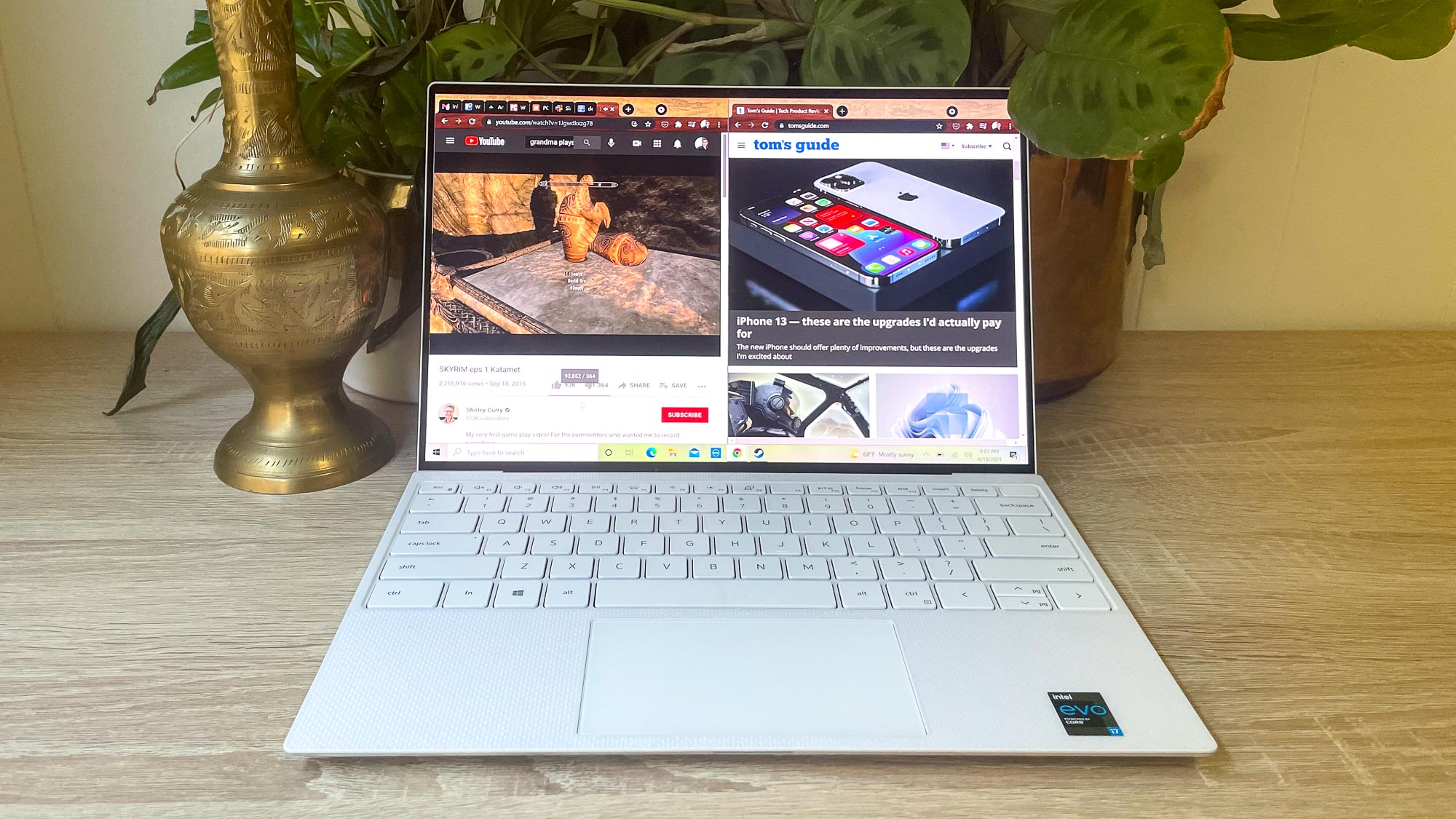
The black bezels of the Dell XPS 13’s patented InfinityEdge display are as thin as ever, and now that they’re wrapped around an OLED screen they almost seem to disappear into the deep black borders of whatever you’re watching. The screen doesn’t reflect much light either, especially when it’s powered on with the brightness cranked up.
However, since this is a touchscreen it is quite vulnerable to picking up prints and smudges during regular use. It’s hardly a deal-breaker, but it is something to keep in mind — and a good reason to throw some kind of cleaning cloth into your laptop bag alongside this machine.
Dell XPS 13 review: Audio
- Well-rounded audio performance
- Weak bass
When it comes time to blast some tunes at your desk or out on the patio, the Dell XPS 13 won’t let you down. Just beneath either edge of the keyboard deck there’s a thin cutout revealing speakers which pump sound out to the sides, helping it fill the room even when the laptop is on a table or lap.
The quality of the sound is pretty good, too; I’m no audio snob, but while streaming tracks like Pink Floyd’s Welcome to the Machine or The Police’s Spirits in the Material World I couldn’t find much fault with the Dell XPS 13’s speakers. Bass comes through clear but without much kick, while more treble-y stuff like vocals and power guitar solos sound warm and sweet.
Dell XPS 13 review: Performance
- 16 GB of RAM and an i7 CPU give the XPS 13 plenty of power for daily tasks
- However, it struggles with demanding games and video work
With an Intel Core i7 CPU and 16 GB of RAM, our Dell XPS 13 review unit had zero trouble handling all my daily tasks without a single stutter. Even when I loaded it up with a frankly unreasonable (40+) number of Chrome tabs, 3 simultaneous video streams from different services, and a 10GB file transfer in the background, the XPS 13 didn’t choke: CPU and SSD usage never went above 50%, and RAM usage never went past 75%.
When we put our review unit to the test using the Geekbench 5.4 multi-core CPU benchmark, it turned in a score of 5,420. That’s better than we saw out of the similarly-equipped 13-inch Microsoft Surface Laptop 4 (4,829), and almost as good as the larger 15-inch Samsung Galaxy Book Pro 360 (5,575).
The Dell XPS 13’s SSD is quite speedy as well, managing to achieve a transfer rate of 742 MBps when tasked with duplicating 25 GB of multimedia files. That’s much faster than the 13-inch Surface Laptop 4 (562 MBps) and nearly as fast as the SSD in the Samsung Galaxy Book Pro 360 (869 MBps).
If you’re looking to do some serious video editing, the XPS 13 can get it done -- but not exactly quickly. In our Handbrake video editing test the laptop transcoded a 4K video to 1080p in 18 minutes and 12 seconds, which is more time than it took the 13-inch Surface Laptop 4 (17:01) or the 15-inch Samsung Galaxy Book Pro 360 (16:24) to complete the same task.
The XPS 13 can get hot under this kind of pressure, too: under the watchful eye of our heat gun the laptop achieved temperatures as high as 98.2 degrees along the top row of the keyboard. During normal lap use I never noticed more than a bearable amount of warmth radiating into my hands and legs, but it definitely gets hot when you try things like playing 3D games with complex graphics.
Dell XPS 13 review: Graphics and game performance
- Most cutting-edge games won't run well
- Older, less demanding games run well and look great
Speaking of which, the addition of an OLED screen hasn’t suddenly turned the Dell XPS 13 into a graphical powerhouse, but it does help games and other apps look great. Without a dedicated GPU this laptop will have a real hard time running the most demanding PC games — good luck getting something approaching a reasonable framerate in Cyberpunk 2077 — but you can still enjoy lots of older or less demanding games.
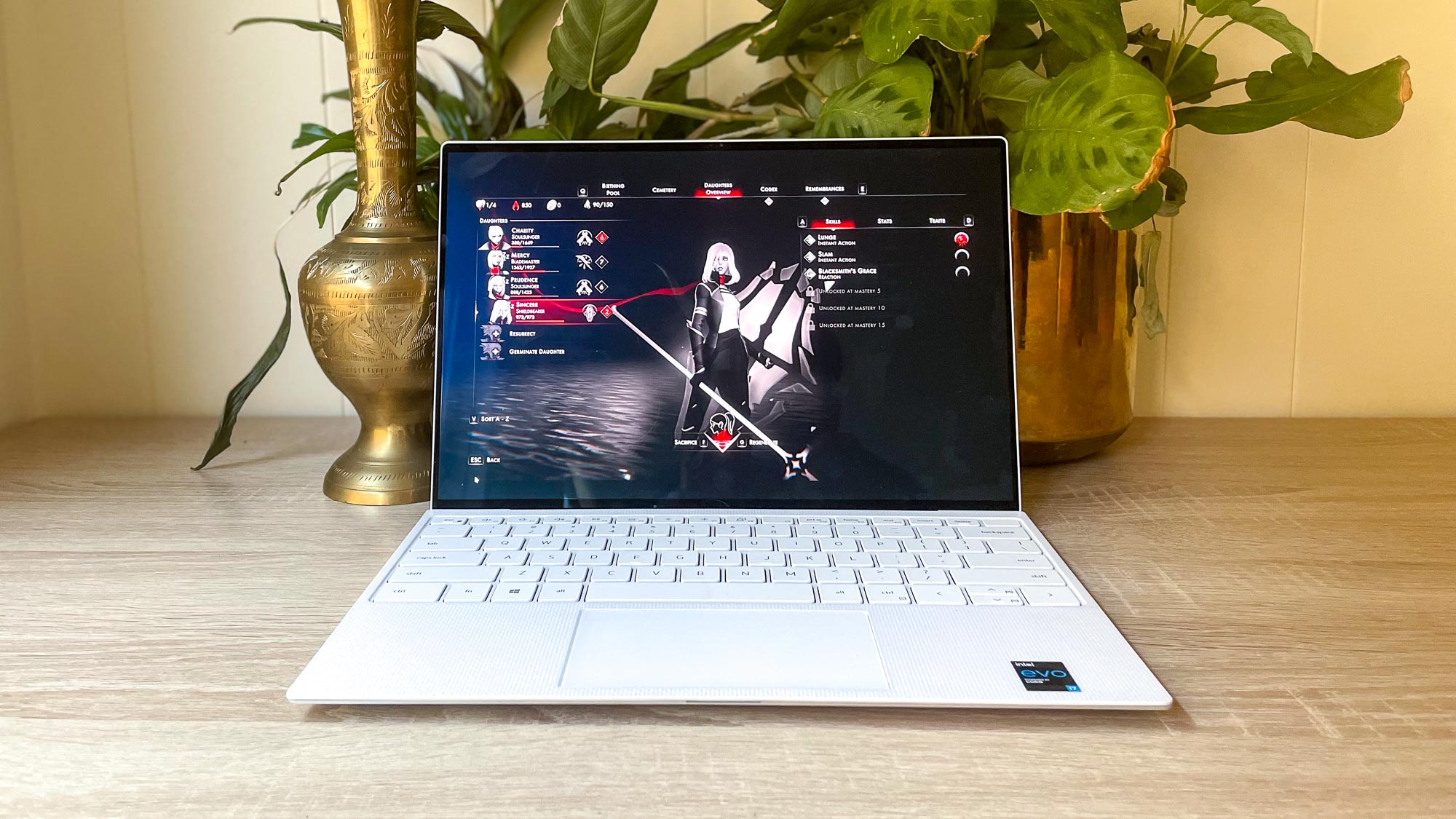
Games like Fortnite, Othercide, Into the Breach, and Crusader Kings III run pretty well on the XPS 13, though performance will dip if you crank the game’s resolution up past 1080p. Sure enough, when we put it to the test using the graphical benchmark in Sid Meier’s Civilization 6: Gathering Storm, the XPS 13 managed to achieve a decent 22.1 frames per second running at 1080p and 14.4 frames per second at its native 3.5K resolution.
Dell XPS 13 review: Keyboard, touchpad and touchscreen
- Sturdy, comfortable keyboard
- Touchscreen works well, but prints and smudges mar the OLED's majesty
It’s hard to find much fault with the Dell XPS 13’s keyboard. If you have large hands you may find the keys a bit cramped and the travel a bit shallow for your tastes, as I do. But that’s hard to avoid on a 13-inch laptop, and after a few days of using the XPS 13 I had no trouble hitting 115 WPM in a 10fastfingers.com typing test. There’s also a fingerprint reader built into the top-right key on the keyboard, affording you the option of logging in and out with a swipe of the finger.
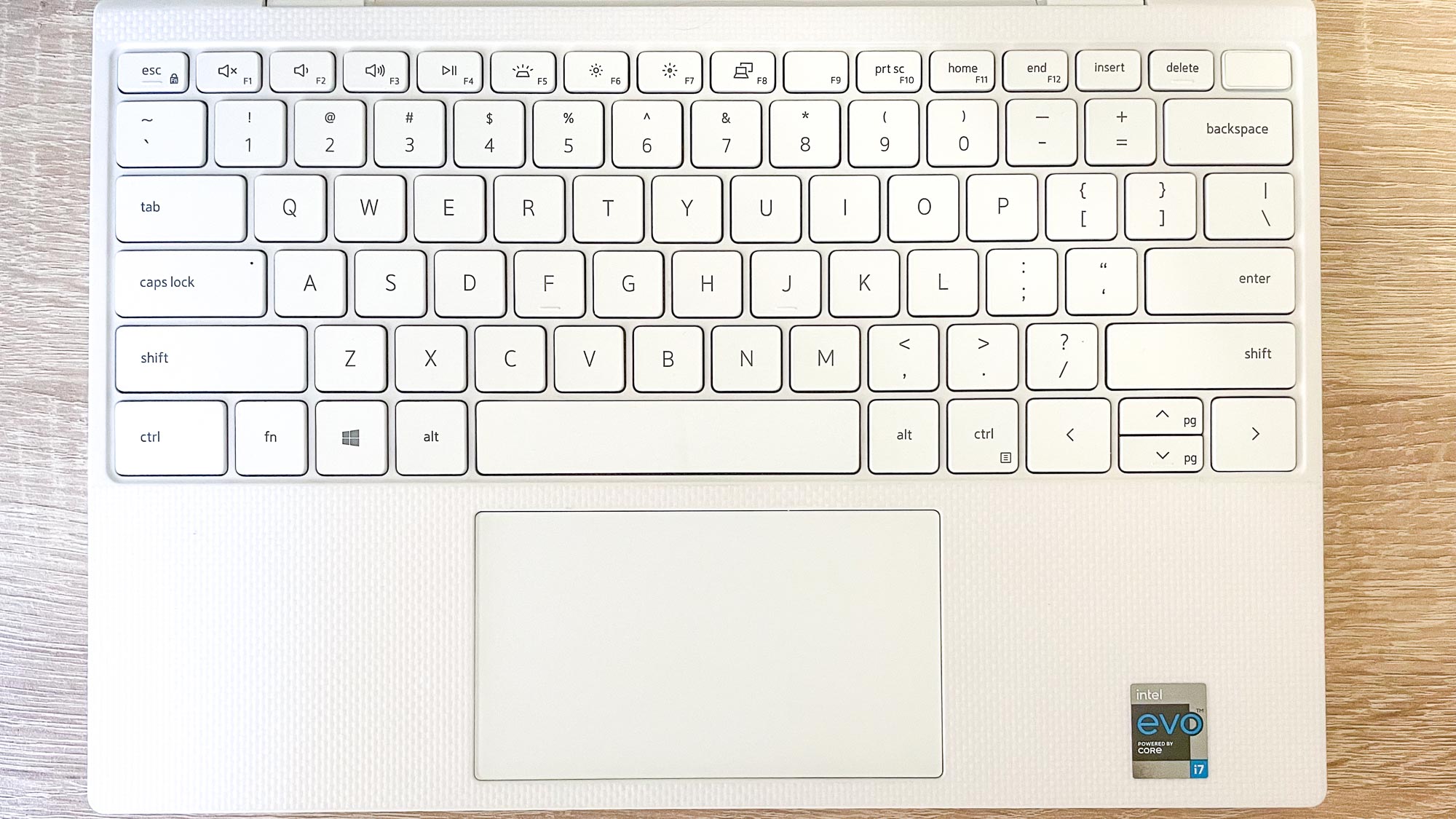
The touchpad beneath the keyboard is equally functional, and I rarely had trouble or noticed missed inputs while using it. It picks up Windows 10’s touchpad gestures very reliably, though I did notice it “lock up” two or three times during testing and stop registering input for a few seconds.
Tapping and swiping on the 3.5K OLED touchscreen feels intuitive and responsive. I found myself pinching and zooming in on webpages and documents frequently, just to make the text more readable on the high-res screen. However, as noted above, do be aware that the screen picks up smudges and prints fairly easily, so it’s a good idea to carry a cleaning cloth with you.
Dell XPS 13 review: Webcam
- 720p webcam delivers serviceable but grainy video quality
- Equipped with IR sensors for Windows Hello facial logins
The Dell XPS 13’s 720p webcam is a tiny dot crowning the top of the display, and it delivers grainy, unexciting picture quality. I happen to own one of the older XPS 13 models with the webcam mounted in the top of the keyboard, which led to a lot of up-the-nose camera angles during video calls; I still feel some lingering gratitude to Dell for moving it up to the top of the screen where it belongs.
Still, it would be nice to see an XPS 13 ship with a 1080p webcam. Such extravagances are still pretty hard to find built into laptops, especially 13-inchers, but with so many of us working remotely amid a global pandemic the quality of our webcams has become more important than ever.
If you like to log in with your face via Windows Hello, good news: the XPS 13’s webcam has IR sensors that allow it to do that for you, affording you a hands-free (albeit slightly creepy) way of unlocking the machine.
- The best webcams for home and office
Dell XPS 13 review: Battery life
- 8-hour battery life is good enough, but not great
- However, it does charge quickly
Sadly, the addition of a 3.5K OLED screen comes at the expense of battery life. In our battery test, which tasks the laptop with endlessly browsing the web over Wi-Fi with the screen set to a brightness level of 150 nits, the Dell XPS 13 w/ OLED managed to last just under 8 hours — 7:59, to be precise.
That’s quite a bit less battery life than either the 13-inch Microsoft Surface Laptop 4 (10:46) or the 15-inch Samsung Galaxy Book Pro 360 (13:33). If you’re open to using a Mac, you’ll get much better battery life from the MacBook Air with M1 (14:41) or the MacBook Pro with M1 (16:32).
For comparison’s sake, in our testing the Dell XPS 13 with a 4K non-OLED screen lasted even less time on a full charge (7:32), while the Dell XPS 13 with a 2K screen lasted hours longer (11:07) in the same test.
However, the XPS 13 does charge pretty quickly: I plugged it in at 5%, and an hour later it was sitting at 51% charged, which is enough to get another two or three hours of use.
Dell XPS 13 review: Verdict
The Dell XPS 13 has been one of our favorite Windows laptops for years, and the addition of a 3.5K OLED screen only enhances the appeal. Paying an extra couple hundred bucks for it might not be worthwhile if you don’t tend to get hung up about image quality, but given that one of the Dell XPS 13’s big attractions is its beautiful, nigh-borderless InfinityEdge display, paying more to slap an OLED in there is a worthwhile addition.
If you want something a little bigger and more performant for roughly the same price, the Samsung Galaxy Book Pro 360 is also a good choice. It has a 1080p AMOLED touchscreen that looks almost as good as the XPS 13’s OLED, with slightly better performance and much better battery life. However, it’s also a larger, heavier 2-in-1 that comes with a lot of Samsung bloatware installed. And of course, if you’re open to using a Mac, the M1-equipped MacBooks offer much better battery life than just about any Windows laptop on the market.
That said, the option to add an OLED display makes one of the best laptops on the market even better. With great performance, good speakers and a beautiful 3.5K OLED touchscreen, the Dell XPS 13 is a premium Windows laptop that should stand you in good stead for years.

Alex Wawro is a lifelong tech and games enthusiast with more than a decade of experience covering both for outlets like Game Developer, Black Hat, and PC World magazine. A lifelong PC builder, he currently serves as a senior editor at Tom's Guide covering all things computing, from laptops and desktops to keyboards and mice.
